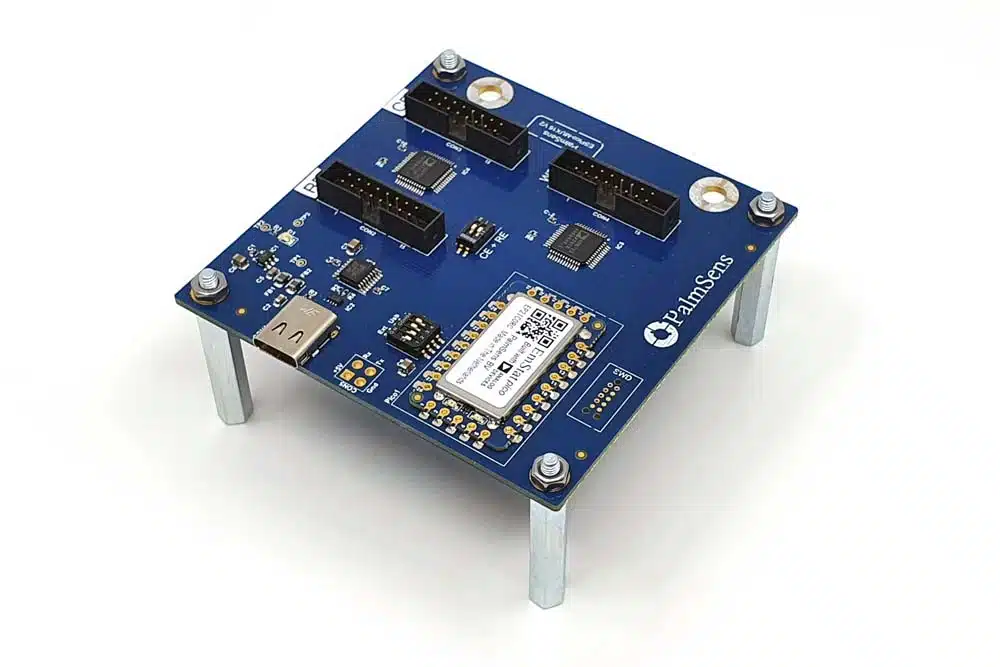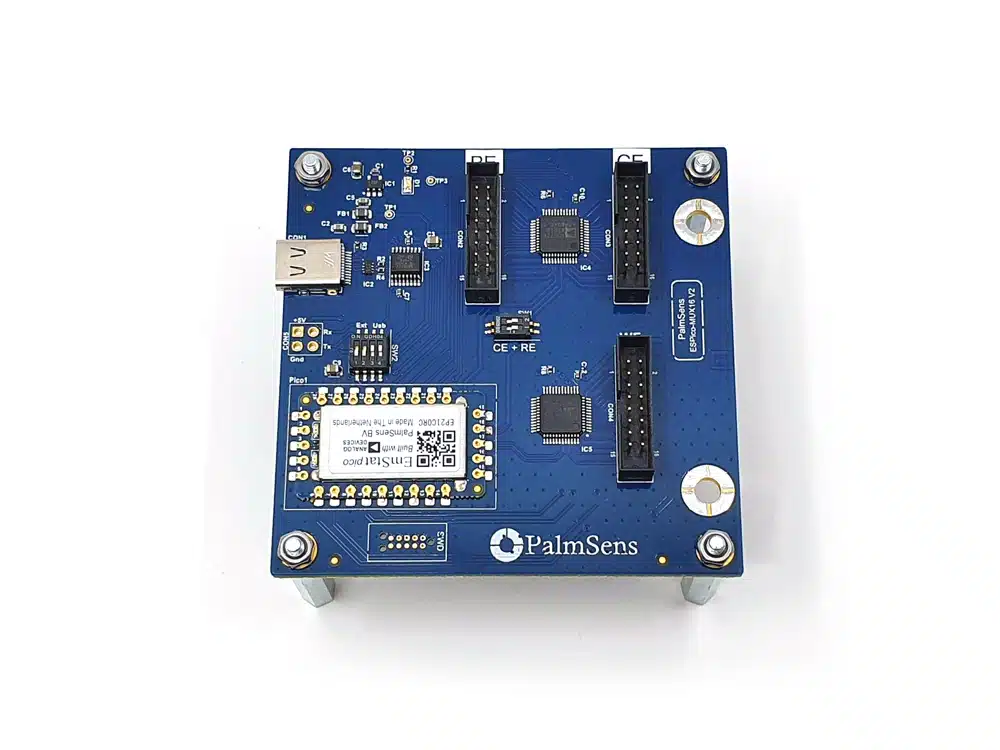EmStat Pico MUX16
16 or 256 channel multiplexer with integrated EmStat Pico
- Great for prototyping a multiplexed EmStat Pico potentiostat module
- 16 individual or 256 combined channels
- Controlled via MethodSCRIPT™
- Access to second working electrode, for example for FET research
Description
The EmStat Pico MUX16 is a developer board equipped with an EmStat Pico potentiostat module and a multiplexer and can be used in two modes:
- MUX16 mode where the WE, RE and CE are all switched at the same time. This allows for 16 individual cells to be connected to the board, each with their own WE, RE and CE.
- MUX256 mode where WE and RE+CE combined are switched separately, allowing 256 channels to be addressed as a matrix.
The multiplexer is controlled using 8 digital IO lines, this effectively creates an 8-bit address for the multiplexer. The 4 LSB bits of the multiplexer address switch the WE, the 4 MSB switch the RE and CE.
The embedded EmStat Pico is a proven, tested and calibrated potentiostat module which enables rapid prototyping, no programming skills are needed. With our free-to-use software PSTrace you can perform electrochemical measurements using your own electrochemical sensor. PSTrace generates MethodSCRIPT to easily reproduce your experiments on the EMstat Pico MUX16 as well as on our Market-Ready OEM instruments, or on your custom PCB. Our tested and calibrated modules are used by over 100+ OEM customers in over 30 countries.
Controlling the EmStat Pico MUX16 with your own code
PSTrace allows you to switch the EmStat Pico MUX16 in measurements using the MethodSCRIPT™ language. The following example script can be used to set channel 2.
e\n #configure all 10 GPIO pins as outputs, add "i" to indicate it is an integer \n set_gpio_cfg 0x3FFi 1\n #Select WE2 and RE2/CE2\n set_gpio 0x11i\n \n
For more information on how to control the EmStat Pico MUX16, please refer to the Getting Started with the EmStat Pico MUX16 document. This script can be sent through the PSTrace MethodSCRIPT Sandbox window or any terminal emulator. Many examples for using MethodSCRIPT on different platforms are available on GitHub.
Specifications
See EmStat Pico module for specifications of the EmStat Pico potentiostat module.
The EmStat Pico MUX16 includes:
- EmStat Pico MUX16 board
- EmStat Pico module (mounted on MUX16 board)
- PSTrace for Windows
- USB flash drive
- USB-C cable
- 3x Flat cable with crimped IDC connectors for the 16 position board connectors
- EmStat Pico MUX16 dummy cell
- Quick Start document
- An activation code card for registering on my.palmsens.com
| General | |
|---|---|
| Multiplexer |
16 channels in 3-electrodes multiplexer mode 256 channels in 2-electrodes matrix mode |
| On resistance | 4Ω typical |
| Charge injection | 1 pC typical |
| Leakage current | 10 pA (per channel) typical at 25 ºC |
Software
Develop software for PC, smartphone or microcontroller
Whether you want to write a simple or advanced Windows application, develop an Android or iPhone app or integrate the EmStat Pico in your own hardware, you can do it with our software development tools and code examples.

Software Development Kits for .NET
The PalmSens Software Development Kits (SDKs) for .NET can be used with any of our instruments or OEM potentiostat modules to develop your own software. The SDK’s come with a set of examples that shows how to use the libraries.
PalmSens SDKs with examples are available for the following .NET Frameworks:
- WinForms
- WPF
- Xamarin (for Android)

MethodSCRIPT™ communications protocol
The EmStat Pico potentiostat module has an on-board parser for the MethodSCRIPT™ scripting language. This language allows developers to program a human-readable script for the EmStat Pico module on any platform or operating system. The simple script language allows for running electrochemical techniques supported by EmStat Pico and makes it easy to combine different measurements and other tasks.

Downloads
Software (9)
| Name | Last updated | |
|---|---|---|
| EmStat Pico Firmware v1.5 See app note "EmStat Pico firmware updating" for more information about updating built-in and bare EmStat Pico modules. | 26-03-25 | |
| PSTrace PC software for all single channel instruments PSTrace software is shipped as standard with all single channel and multiplexed instruments. The software provides support for all techniques and device functionalities. | 08-07-24 | |
| PalmSens SDK for Python PalmSens Python SDK 5.12 with support for instruments from PalmSens BV on Windows systems. | 07-11-22 | |
| EmStat Pico Firmware v1.3.4 See app note "EmStat Pico firmware updating" for more information about updating built-in and bare EmStat Pico modules. | 13-12-21 | |
| EmStat Pico Firmware v1.2 See app note "EmStat Pico firmware updating" for more information about updating built-in and bare EmStat Pico modules. | 13-12-21 | |
| MethodSCRIPT Examples for the EmStat Pico MUX16 in Python Use these MethodSCRIPT examples together with the "Getting Started with the Emstat Pico MUX16" guide. | 30-06-21 | |
| Getting started with PalmSens SDK for WPF This manual explains how to use the SDK with the included libraries and examples. | 07-06-21 | |
| Getting started with PalmSens SDK for WinForms This manual explains how to use the SDK with the included libraries and examples. | 07-06-21 | |
| Getting started with PalmSens SDK for Android This manual explains how to use the SDK with the included libraries and examples. | 07-06-21 |
Documentation (10)
| Name | Last updated | |
|---|---|---|
| EmStat Pico communication protocol v1.5 This document describes the “online” communication protocol of the EmStat Pico. Initial communication with an EmStat Pico is always done using this online communication. Measurements and other scripts can be started by sending a MethodSCRIPT, | 26-03-25 | |
| MethodSCRIPT v1.7 The MethodSCRIPT scripting language is designed to improve the flexibility of the PalmSens potentiostat and galvanostat devices for OEM users. It allows users to start measurements with arguments that are similar to the arguments in PSTrace. PalmSens provides libraries and examples for handling low level communication and generating scripts for MethodSCRIPT devices such as the EmStat Pico and EmStat4. | 26-03-25 | |
| MethodSCRIPT v1.5 The MethodSCRIPT scripting language is designed to improve the flexibility of the PalmSens potentiostat and galvanostat devices for OEM users. It allows users to start measurements with arguments that are similar to the arguments in PSTrace. PalmSens provides libraries and examples for handling low level communication and generating scripts for MethodSCRIPT devices such as the EmStat Pico and EmStat4. | 25-03-24 | |
| EmStat Pico and EmStat4 bootloader commands This document explains how to enter the bootloader of the EmStat Pico or the EmStat4M and update the firmware. | 05-10-23 | |
| MethodSCRIPT v1.4 The MethodSCRIPT scripting language is designed to improve the flexibility of the PalmSens potentiostat and galvanostat devices for OEM users. It allows users to start measurements with arguments that are similar to the arguments in PSTrace. PalmSens provides libraries and examples for handling low level communication and generating scripts for MethodSCRIPT devices such as the EmStat Pico and EmStat4. | 01-02-23 | |
| EmStat Pico MUX16 – Brochure EmStat Pico MUX16 Brochure | 09-09-22 | |
| EmStat Pico MUX16 Schematics Schematics of the EmStat Pico MUX16. | 18-08-22 | |
| EmStat Pico communication protocol v1.3 This document describes the “online” communication protocol of the EmStat Pico. Initial communication with an EmStat Pico is always done using this online communication. Measurements and other scripts can be started by sending a MethodSCRIPT, | 13-06-22 | |
| MethodSCRIPT v1.3 The MethodSCRIPT scripting language is designed to improve the flexibility of the PalmSens potentiostat and galvanostat devices for OEM users. It allows users to start measurements with arguments that are similar to the arguments in PSTrace. PalmSens provides libraries and examples for handling low level communication and generating scripts for MethodSCRIPT devices such as the EmStat Pico and EmStat4. | 19-01-22 | |
| Getting Started with the Emstat Pico MUX16 This description explains how to address the MUX16, enable the MethodSCRIPT sandbox editor in PSTrace, customize MethodSCRIPT and perform your first measurement using our 16 resistor test cell. | 10-06-21 |
Application Note (1)
| Name | Last updated | |
|---|---|---|
| Characterization of Field Effect Transistors Characterization of a Field-effect Transistor (FET) using an EmStat Pico potentiostat module. | 09-11-22 |
Other (2)
| Name | Last updated | |
|---|---|---|
| Introduction to electrochemical sensing – Tutorial The first part of this presentation contains how electrochemistry works and how it can be used for sensing applications. The second half explains what a potentiostat is and which applications are suitable for the EmStat Pico potentiostat offered by PalmSens. Details of the EmStat Pico’s capabilities will be shown, as well as instructions on how to use it. | 15-07-21 | |
| EmStat Pico MUX16 3D step file 3D model of the EmStat Pico MUX16. | 09-06-21 |






















